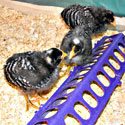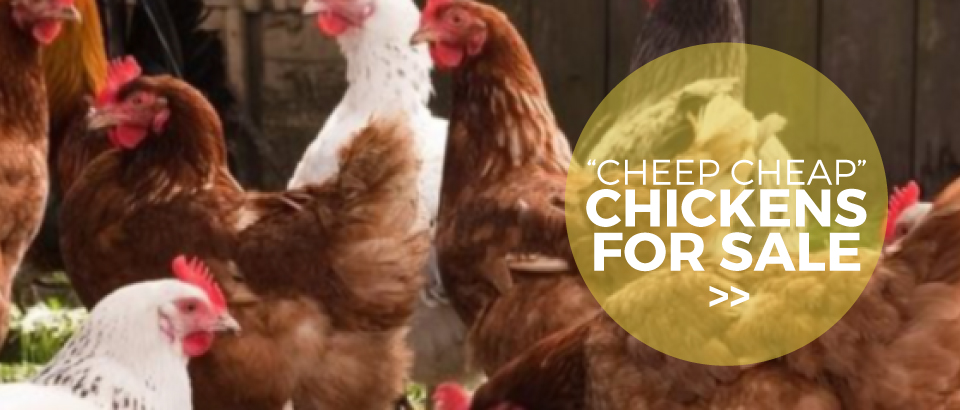
When you raise baby chickens in a brooder you must gradually change the brooding facilities as the chicks grow. After about the first two weeks of brooding, start making necessary changes to the following features:
Adequate space for the number of birds
Initially chicks don’t need much room, because (like other babies) they spend much of their time sleeping. If you start out with a large brooder you can block off a portion of it for the first days to keep the baby birds close to the sources of food, water, and heat. As the birds grow and become more active, they will need an ever increasing amount of room, both to avoid stress and conflicts and to prevent a too-rapid buildup of moisture and manure. Provide additional space either by moving them to larger quarters or by opening up portions of the brooder you originally blocked off.
A reliable and adjustable heat source
A chick’s body has little by way of temperature control, although a group of chicks can stay warm by huddling together in a small space — which is how baby chicks stay warm when shipped by mail. Given sufficient space to move around within a brooder, chicks need an external source of warmth until the down covering their bodies gives way to feathers, starting at about three weeks of age. As they grow they need gradually less external heat, because their bodies gradually generate more warmth that helps heat up the brooder. Accordingly, the brooding temperature must be systematically reduced as they grow.
Escape-proof design
Chicks can squeeze through the smallest openings. A brooder that lacks a sliding adjustable gate to prevent escape should be solid for at least 6 inches up from the floor. At about three weeks of age, the chicks will start exercising their wings and will soon try to perch on anything their tiny wings let them fly onto. Chicks kept in a brooder with low walls and no cover may inadvertently escape when they perch on the brooder’s edge and then come back down on the wrong side. One way to discourage them from perching on the edge of the brooder is to furnish low comfort roosts.
Protection from children, pets, and predators
The safest sort of poultry brooder is one that entirely encloses the chicks and must be opened purposely to tend to their needs. Inside the family home, exuberant children and excited pets can harm delicate chicks without meaning to. A brooder set up in a garage or outbuilding must offer protection from such predators as weasels, rats, and snakes. If you plan to brood chicks once, or only occasionally, less expensive brooder options include a premium brooder starter package, a chick starter kit or even a sturdy cardboard box.
Proper flooring for baby birds
The brooder floor should not be so slippery chicks can’t walk without sliding, nor should it be covered with a type of bedding chicks will trip over, have trouble walking on, or be attracted to eat. The suitability of bedding and flooring changes as chicks grow. A popular brooding method is to start out covering the brooder floor with paper towels, and after a few days (when the chicks become more active and are eating well from the feeder), switch to shavings or other loose litter.
Suitable feeders and waterers
Different styles of feeders and waterers are available that have been designed specifically for baby poultry. In most cases you’ll need to change both the feeders and the waterers to larger styles as the chicks grow. You’ll also need to increase their height from the brooder floor, both to keep litter and droppings out of the feed and water, and to make eating and drinking comfortable for the growing chicks. Become familiar with what chicks eat and with watering baby chicks in a brooder.
Sufficient light to find feed and water
Furnish continuous light for the first 48 hours while the baby chicks are getting oriented to the brooder and to the feeders and drinkers. Thereafter, turn the light off when you go to bed at night and turn it back on in the morning. Or put the light on a timer that allows at least 8 hours of darkness per 24 to give chicks a chance to rest. If your heat source is also the source of light, use a red bulb to reduce stress and discourage the chicks from picking at each other.
Continuous light is unnatural and unhealthful for birds. For this reason, an infrared hanging radiant heater that does not emit light is better for brooding purposes than a heat bulb that lights the brooder 24/7. If the brooding area gets plenty of natural light through windows or is situated in a well-lighted room, it may get sufficient light without an additional brooder light. Watch to see that the chicks continue to eat and drink at the normal rate.
And that’s today’s news from the Cackle Coop.
Gail Damerow, author, Hatching and Brooding Your Own Chicks (Chickens, Turkeys, Ducks, Geese, Guinea Fowl)


